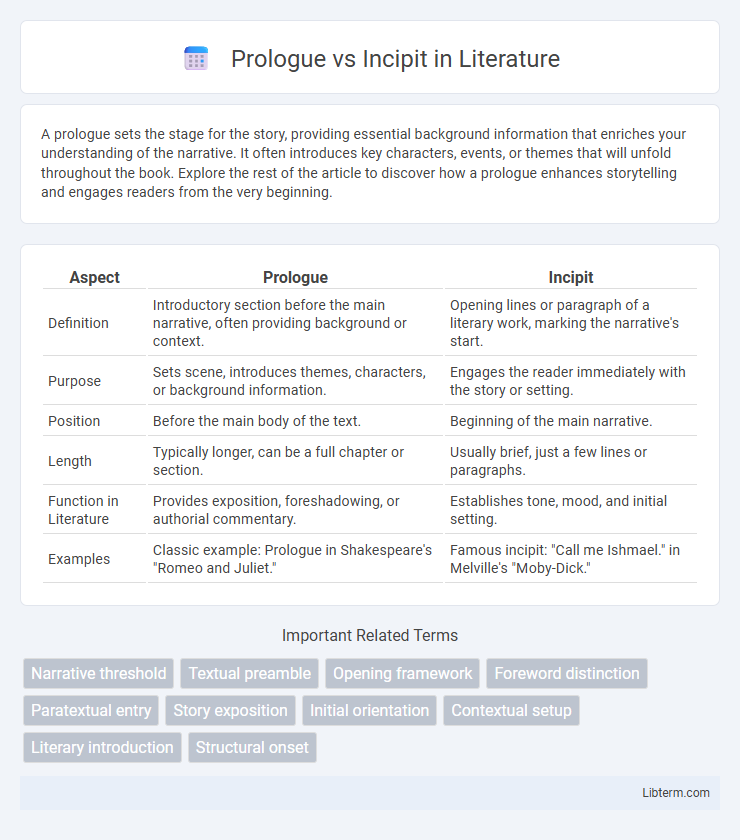A prologue sets the stage for the story, providing essential background information that enriches your understanding of the narrative. It often introduces key characters, events, or themes that will unfold throughout the book. Explore the rest of the article to discover how a prologue enhances storytelling and engages readers from the very beginning.
Table of Comparison
| Aspect | Prologue | Incipit |
|---|---|---|
| Definition | Introductory section before the main narrative, often providing background or context. | Opening lines or paragraph of a literary work, marking the narrative's start. |
| Purpose | Sets scene, introduces themes, characters, or background information. | Engages the reader immediately with the story or setting. |
| Position | Before the main body of the text. | Beginning of the main narrative. |
| Length | Typically longer, can be a full chapter or section. | Usually brief, just a few lines or paragraphs. |
| Function in Literature | Provides exposition, foreshadowing, or authorial commentary. | Establishes tone, mood, and initial setting. |
| Examples | Classic example: Prologue in Shakespeare's "Romeo and Juliet." | Famous incipit: "Call me Ishmael." in Melville's "Moby-Dick." |
Understanding Prologue and Incipit
A prologue serves as an introductory section that provides background information, sets the scene, or offers insight into the story's context before the main narrative begins. The incipit marks the actual opening words or sentences of the text, initiating the story's progression and tone directly. Understanding the distinction between prologue and incipit enhances comprehension of narrative structure and authorial intent.
Defining the Prologue in Literature
The prologue in literature serves as an introductory section that provides essential background information, context, or exposition before the main narrative begins. It often establishes the setting, introduces key characters, or reveals crucial events that influence the story's development. Unlike the incipit, which is simply the opening line or phrase of a text, the prologue functions as a distinct narrative device that frames the plot and enhances reader comprehension.
What is an Incipit?
An incipit is the opening phrase or sentence of a manuscript, book, or document, serving as the initial textual entry point. Unlike a prologue, which functions as an introductory section providing background or context, the incipit marks the very beginning of the narrative or main text itself. In medieval manuscripts and early printed works, the incipit held significant importance for identifying and referencing texts.
Historical Origins of Prologue and Incipit
The prologue originated in ancient Greek theater as an introductory speech providing background information to the audience, setting the stage for the narrative. The incipit, derived from Latin meaning "it begins," historically refers to the opening words or phrase of a manuscript or text, serving as an identifier in early literary traditions. Both elements evolved to guide readers through a work, with the prologue offering context and the incipit marking the formal start of the text.
Purpose of a Prologue in Storytelling
A prologue in storytelling serves to provide essential background information, set the tone, or introduce key themes before the main narrative begins. It often reveals critical events or perspectives that influence the story's context, enhancing reader engagement and understanding. Unlike an incipit, which simply marks the start of the text, a prologue actively frames the story's foundation and prepares the audience for what follows.
The Role of the Incipit in Narrative Beginnings
The incipit serves as the narrative's initial gateway, establishing tone, setting, and urgency that engage readers immediately. Unlike a prologue, which often provides background or context separate from the main narrative, the incipit integrates seamlessly into the story's opening, creating an immersive entry point. This direct immersion through the incipit is crucial for anchoring the reader's attention and orienting them within the narrative world.
Key Differences Between Prologue and Incipit
A prologue serves as a separate introductory section in a literary work, often providing background, context, or foreshadowing, while an incipit is simply the opening words or sentences of the main text itself. Prologues may establish setting or introduce characters unrelated to the immediate narrative, whereas incipits immerse the reader directly into the story's beginning without detaching from the main plot. The key difference lies in function: prologues act as a preliminary narrative to frame the story, while incipits mark the official start of the narrative's flow.
When to Use a Prologue vs. an Incipit
A prologue is used to provide background information, set the tone, or introduce key elements before the main narrative begins, often offering a glimpse into events that influence the story. An incipit serves as the opening line or passage, immediately immersing the reader in the narrative without extensive exposition. Use a prologue when context or backstory is essential for understanding, while an incipit is ideal for starting the story directly and capturing interest from the first word.
Famous Examples of Prologues and Incipits
Prologues often appear in classic literature like Shakespeare's *Romeo and Juliet* and Chaucer's *The Canterbury Tales*, setting context or tone before the main narrative begins. Famous incipits include the iconic opening of *Moby-Dick*: "Call me Ishmael," which immediately introduces the narrator and hooks readers. These literary techniques enhance storytelling by providing background (prologue) or initiating the story directly (incipit) in renowned works.
Choosing the Right Opening for Your Story
Selecting the appropriate opening between a prologue and an incipit hinges on the story's purpose and reader engagement goals. A prologue offers background information or sets a mysterious tone, often providing context separate from the main narrative, while an incipit launches directly into the primary story, establishing immediate momentum and character immersion. Writers should evaluate whether their tale benefits from preliminary exposition or prefers a compelling start that hooks readers instantly.
Prologue Infographic

 libterm.com
libterm.com